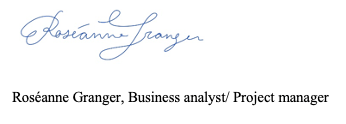
The Dynamics of Project Management Interaction
Managing large projects is not without its challenges. The chances of success are based on three main areas: technology, human resources, and processes. While the technology and process aspects can be learned through theory and experience, the human resources sphere can be more difficult to understand. Indeed, it’s important to communicate effectively with all the actors involved during every step of the project, whether as a project manager to motivate team members or as a team leader to mobilize the troops. The key to success is to tailor your interactions. Not only must you adapt to each interlocutor, but you must also consider the particular type of exchange that is required. A status meeting requires a different dynamic than a watercooler chat, for instance.
In January 2022, DBC completed an in-house psychometric assessment to identify the team’s different interaction dynamics. The exercise provided a better understanding of the behaviours encountered in project management mandates. In this article, we will present the communication model used by Les Alchimistes Conseils, which outlines the four different communication styles along with a description of how these styles relate to one another. We will then explore the implementation of this analysis in a company and present various potential benefits.
COMMUNICATION MODEL
The model used by Les Alchimistes Conseils represents the different dynamics of communication and is composed of two scales to evaluate the individual’s communication behaviour. The first scale, the caution and assertiveness scale, represents the interaction of the individual who must make a decision or choose a position. The second scale, the spontaneity and self-control scale, corresponds to the expression of interpersonal behaviours.
At the four ends of the model are the major communicative style categories, each represented by a colour. In order to refine the range of interactive dynamics, each category is subdivided into four sections, offering more nuanced variations towards the centre or towards another adjacent colour. The following figure is a graphical representation of the model, providing a clear visualization of the different dynamics.

Figure 1 :The nuances in the dynamics © Ngenio
Each communication style has its own colour; yellow = expressive, red = driver, green = analytical, and blue = amiable. Such a model allows similar behaviours to be grouped together, providing a framework for categorization and analysis. Four main communication styles are isolated, each one allowing us to identify several strategies to better relate to a colleague demonstrating a particular dynamic.
IDENTIFYING THE DYNAMICS OF COMMUNICATION
More concretely, how can we use the knowledge of interaction dynamics in our workplace?
This can be done in two easy steps:
- -Identify the dynamic demonstrated by an individual;
- -Adapt your communication style to the individual according to their dynamic.
Ways of adapting to different dynamics have already been proposed. All that remains is to identify the type of person we are dealing with in an interaction.
Using the two axes of the model then becomes very valuable for this task. The four main categories of dynamics are categorized according to the caution and assertiveness axis as well as the self-control and spontaneity axis.
The first axis is tied to the way an individual makes a decision, forms an opinion, or chooses a position. A person who typically asks rather than asserts, favours a cooperative spirit, communicates diplomatically, and is flexible in their opinions leans more towards the cautionary side of this axis. Conversely, a person who tends to demand rather than ask, favours competition, acts quickly, communicates in a direct manner, and is rigidly opinionated would fall on the more assertive side of the axis. The question to ask is, “How does this individual tend to take a position and defend it?”
The second axis refers to an individual’s interpersonal behaviour. A person who tends to be fact-based, formal, and rational, preferring to work alone while valuing concrete achievements, is on the self-control side of the second axis. On the other hand, an individual who typically trusts their emotions, prefers informal interactions, displays warmth, and seeks collaboration and group acceptance is on the spontaneity side. The question to ask in regards to the second axis is, “In what way does this individual tend to operate in the workplace?”
By positioning the individual’s interaction style according to these two axes, it will be easier for us to get an idea of the category to which the individual belongs.
UNDERSTANDING THE DIFFERENT DYNAMICS OF INTERACTION IN PROJECT MANAGEMENT
To better understand this four-category communication model, it is necessary to grasp the different dynamics of interaction. This understanding will help to better identify the different behavioural profiles and to facilitate interactions between team members.
There are no good or bad profiles, only good or bad circumstances! The stress of adapting and seeing one’s plans potentially fail could exacerbate certain personality traits and make an individual appear less favourable.
Driver
A driver is assertive and self-controlled, with a strong desire to achieve results through productivity. They seek to win at all costs and to be successful in their professional lives. On the plus side, a driver is comfortable with confrontation, ably handling risky and demanding situations. They also excel at planning and organizing while always maintaining a clear focus on completing goals. However, under stress, they can sometimes become controlling and even rather authoritarian.
Expressive
An expressive individual is self-assertive and spontaneous. Generally optimistic and forward-looking, they work with others to achieve results. Among their advantages, they react swiftly to changes and propose innovative solutions. An expressive individual is confident, has a strong spirit of initiative, and boasts a keen sense of urgency. They are also rather optimistic and persuasive. Under stress, an expressive person may appear to invade the others’ spaces and apply pressure to get what they want.
Analytical
An analytical person can be described as cautious and self-controlled. They are generally persistent, tenacious, and consistent. Often resistant to change, they have well-defined values and good self-esteem despite their need for security. Analytical individuals are rigorous in their attention to detail and accuracy. They are generally well-organized and logical, boasting a strong ability to maintain concentration. They are also adept at handling technical information. However, they may appear sceptical of new ideas, lack enthusiasm, be resistant to change, and be overly cautious.
Amiable
An amiable/cooperative person is more cautious and spontaneous compared to other interaction dynamics. They prefer harmony, complete calm, tranquillity, and consent, while maintaining a strong sense of belonging. On the plus side, they tend to value team performance, facilitating discussions, involving others, seeking consensus, and solving problems as a group. However, they can appear more conservative, overly cautious, and resistant to changes that appear risky. They can also buckle easily under pressure.
The key to a good analysis is to start by positioning ourselves within the communication model before categorizing our colleagues. A good understanding of our strengths and challenges then provides the opportunity to be more effective in our efforts to facilitate project management.
THE TEST’S BENEFITS
Whether in a personal or professional setting, it is important to take into account how others perceive us in order to better understand the dynamics of interaction, which can give us a head start in facilitating relationships with clients. Communication and decision-making with clients can be more rewarding and mutually beneficial. Knowledge of communication dynamics can subsequently help to form more balanced teams and to optimize the allocation of various roles and tasks.
Through a better understanding of workplace communication issues and interaction dynamics, it is possible to more effectively manage conflicts and the potential issues that may arise from them. Moreover, introspection can help in acquiring and expanding life skills, such as the function of choice, self-fulfilment, and professional identity. In order for one to evolve, there must be a degree of awareness. Staying alert, being aware of communication dynamics, and regularly questioning oneself can greatly help in gaining a deeper understanding of oneself and in identifying social phenomena.
Conclusion
The benefits of using a method such as the one presented by Les Alchimistes Conseils, which identifies the dynamics of interaction in a company by categorizing the behaviour of each individual according to two axes, are numerous. In essence, this test helps each person to introspect on their interaction dynamics and to analyze their work environment in order to discern various behaviours. It can therefore help to facilitate interactions between members of a project management team.
However, it is important to bear in mind the limitations of this test, which presents only a very limited range of possibilities, linked to just four categories of behaviour. Moreover, categorizing people’s behaviour in such a way does not do justice to the complexity of human interaction. It is therefore important to go even deeper in the analysis and to avoid using it as a tool for predicting interactions.
With the advent of new communication methods, are we truly able to use all these tools properly? Whether as a project manager, team leader, or an integral part of a team, it is our duty to adjust to the evolution of communication. The standards for technical skills and the ability to adapt to clients’ needs are changing, and keeping pace with the digital marketplace is becoming paramount. In order to strive for excellence and reach our full potential, it is crucial to develop a robust understanding of interaction patterns to facilitate communication while adapting to individuals and the growing expectations of the consulting field.
About Les Alchimistes Conseils
The MPO test (Mobilisation et Performance Organisationnelle / Mobilization and Organizational Performance) was created in Quebec in 2010 by a team of organizational development professionals. A talent management consulting firm, Les Alchimistes Conseils is a community of consultants who help companies succeed by maximizing human potential and working on communication, teamwork, and strategy alignment.






